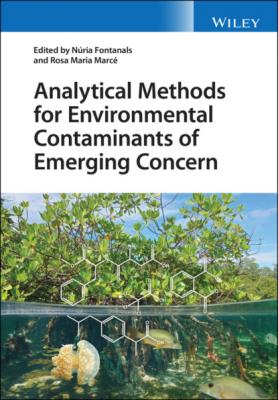Analytical Methods for Environmental Contaminants of Emerging Concern. Группа авторов
Читать онлайн.| Название | Analytical Methods for Environmental Contaminants of Emerging Concern |
|---|---|
| Автор произведения | Группа авторов |
| Жанр | Химия |
| Серия | |
| Издательство | Химия |
| Год выпуска | 0 |
| isbn | 9781119763888 |
aAbbreviations: CUPs: Current-use pesticides; GC: Gas chromatography; LC: Liquid chromatography; MAE: Microwave-assisted extraction; MS: Mass spectrometry; MS/MS: Tandem mass spectrometry; OCPs: Organochlorine pesticides; QqQ: Triple quadrupole; TPs: Transformation products; UAE: Ultrasound-assisted extraction; PAS. Passive air sampler; PUF: Polyurethane foam; UHPLC: Ultra-high-performance liquid chromatography.
bLimit of detection provided as ng VERAM−1.
cLimit of detection.
1.3 Determination of Pesticides
Current analytical methods for pesticide residue analysis are mainly based on the use of chromatographic techniques (GC or LC), depending on their polarity and volatility among other factors, coupled to MS analyzers. As an example, Figure 1.5 shows the chromatograms of a blank soil sample spiked with 218 pesticides by LC-MS/MS and GC-MS/MS, observing the potentiality of these techniques to analyze a wide range of compounds.
Figure 1.5 Chromatograms of the targeted pesticides by LC-MS/MS (A) and GC–MS/MS (B) of a blank soil sample spiked at 20 ng g−1. Source [99]. Reproduced with permission of Elsevier B.V.
1.3.1 Development of the Instrumental Method
1.3.1.1 Chromatography
GC enables the detection of a high number of volatile or semivolatile and thermally stable pesticides, allowing the determination of persistent pesticides in environmental matrices such as water, soil, biota and air (Tables 1.1–1.4). Several multiresidue methods have been developed and, for instance, 11 OCPs were determined in soils using GC with a DB-5-MS capillary column with 5% phenyl stationary phase and 95% of methylpolysiloxane [106]. Although this is the stationary phase most commonly used, other stationary phases, such as DB-XLB and DB-35-MS, were also tested for the determination of endosulfan, chlorpyrifos and their metabolites [29], obtaining the best results with DB-XLB (larger differences in the retention time of the compounds). ZB-5MSi was also tested to determine pyrethroid pesticide metabolites in soil samples [64] and a HP-5-MS UI column to analyze 58 pesticides in soil samples [61]. Additionally, pesticides can simultaneously be analyzed with other pollutants such as polycyclic aromatic hydrocarbons (PAHs), brominated diphenyl ethers (BDEs) and polychlorinated biphenyls (PCBs) in environmental matrices, such as surface waters [84], accomplishing this with the Environmental Quality Standards (EQS) fixed by Directive 2013/39/EC [10].
For non-GC amenable compounds, although chemical derivatization can be carried out, LC is recommended and liquid chromatography (LC) and, increasingly, ultra-high-performance liquid chromatography (UHPLC) are commonly used for the analysis of pesticides, using different particle sizes as 5 µm [107], 3 µm [62] or even lower (1.8 µm) [28]. For LC-amenable pesticides, conventional C18 columns are commonly used [57], with generic mobile phases such as methanol and water 0.1% formic acid 4 mm ammonium formate, allowing, for instance, the determination of parent pesticides (famoxadone) and metabolites [28]. Moreover, hydrophilic interaction liquid chromatography (HILIC) has been proposed as a promising tool for highly polar pesticides in fresh water [72] whereas a mixed-mode stationary phase is an interesting alternative [108], allowing the separation of a wide range of compounds such as polar, medium and non-polar ones. Thus, a mixed column such as XDB-C18 was used to determine 30 pesticides (herbicides, fungicides and insecticides), using as mobile phase acetonitrile and water 0.1% formic acid [93], or an EC-C18 column, using mobile phases that consisted of methanol 0.1% formic acid and 2 mm ammonium acetate, and water 0.1% formic acid and 2 mm ammonium acetate, allowing the determination of 218 pesticides [99].
As can be observed in Tables 1.1–1.4, different multiresidue and multiclass methods based on LC-MS have been reported in recent years. Robust and reliable analytical methods have been developed, allowing for the monitoring of ca. 500 pesticides in surface and groundwaters [23], 215 pesticides and TPs in groundwater [25], as well as 251 emerging contaminants in surface water [75].
In the last years, chiral columns were also employed to determine enantiomers of pesticides [65], using different specific stationary phases, such as Chiralcel OD-RH column and a mobile phase consisting of acetonitrile and water 0.1% formic acid, or a Chiralcel OD-3 [97], that allows the determination of pydiflumetofen enantiomers in soil samples.
On the other hand, despite the proved potential of supercritical fluid chromatography (SFC) [108–110], its application in the analysis of environmental samples is still scarce. For instance, SPE was combined with SFC for the analysis of 8 emerging contaminants, including the diuron herbicide, in river water [111]. Ionic chromatography (IC) coupled with MS has tested for the analysis of polar pesticides, such as glyphosate, AMPA, glufosinate and MPPA in surface water [112], being an interesting alternative to HILIC or approaches.
1.3.1.2 Detection
Different classical detectors have been applied for the determination of target pesticides in environmental samples, such as flame ionization detector (FID) [68] and electron capture detector (ECD) [45, 63, 86] in combination with GC. Likewise, LC coupled to a UV-Vis detector was used for the analysis of organophosphorus pesticides in soils samples [113], or to a fluorescence detector, which was utilized
